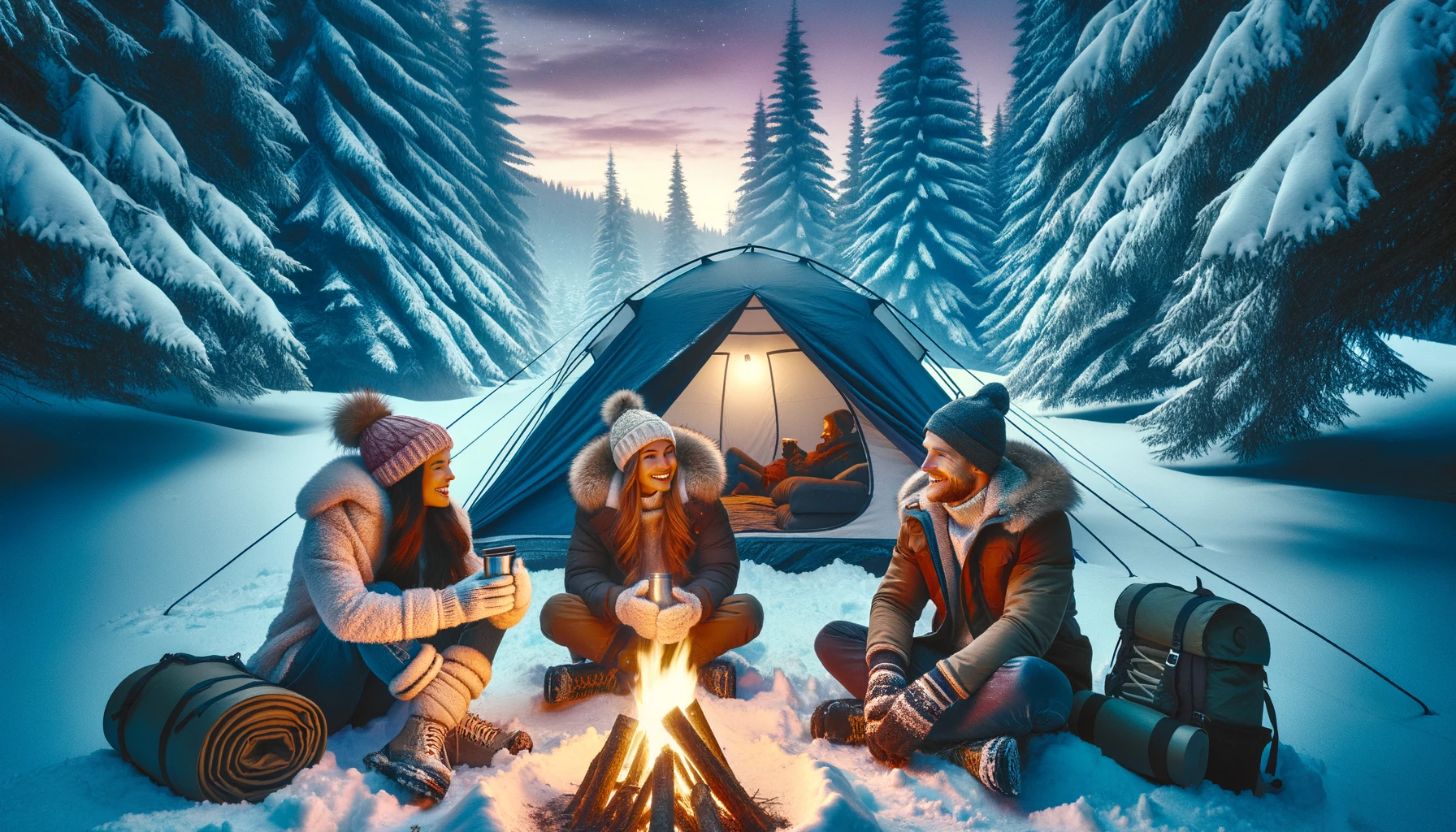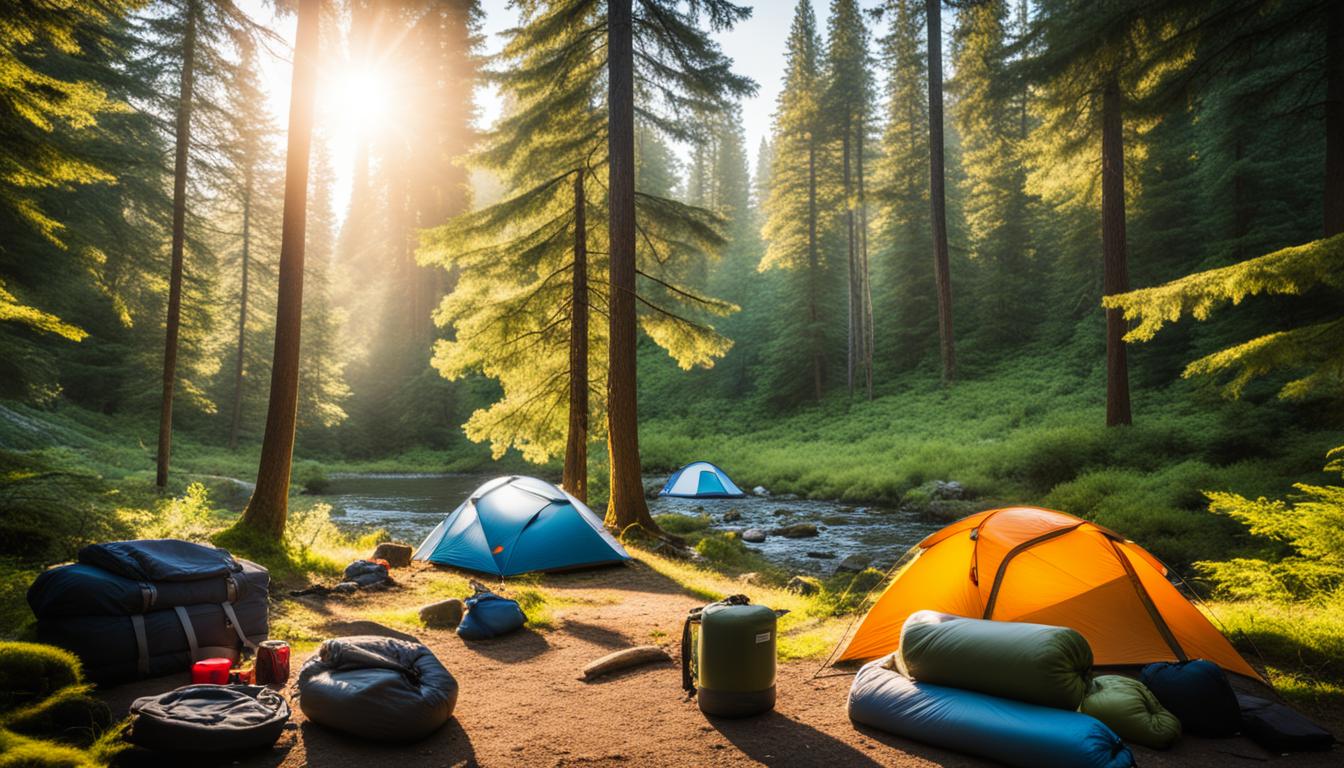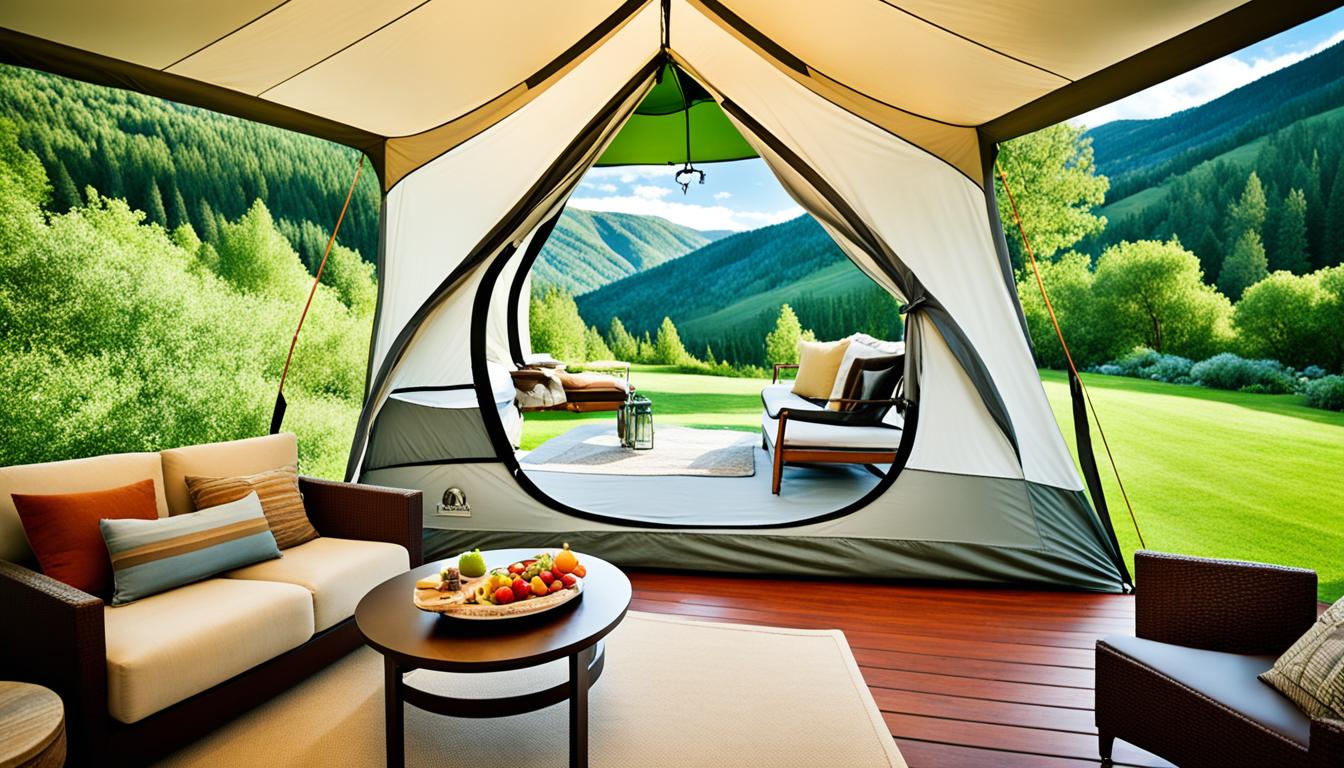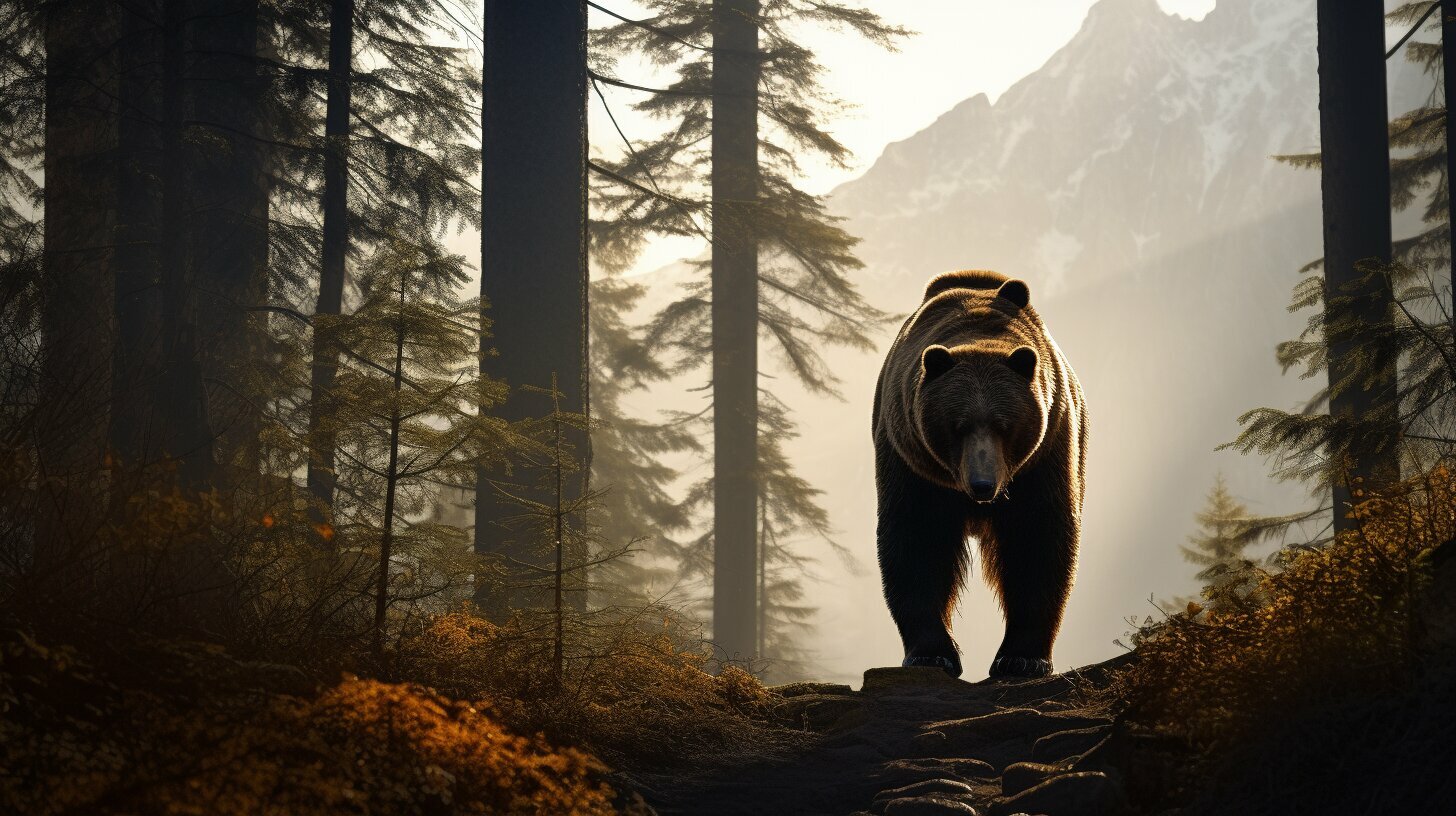Winter camping can be a thrilling and unforgettable experience, but it also comes with unique challenges and risks. You’ll need to be prepared for colder temperatures, harsh weather conditions, and limited daylight hours. That’s why we’ve compiled essential winter camping tips to help you stay warm, safe, and comfortable in the great American outdoors. From gear and equipment recommendations to safety precautions and strategies for keeping warm, we’ve got you covered.
Key Takeaways
Disclosure: When you buy through links on our site, we may earn an affiliate commission.
- Winter camping requires additional preparation and gear
- You should take safety precautions to prevent hypothermia, frostbite, and other cold-related injuries
- Layering clothing, using appropriate sleeping bags and pads, and hand and feet warmers can help you stay warm
- Cooking and preparing food in cold weather can be challenging, but it’s crucial to stay nourished and hydrated
- Choosing the right campsite and setting up camp properly are essential for a safe and enjoyable winter camping experience
Planning for Winter Camping
Winter camping requires careful planning and preparation to ensure a safe and enjoyable experience. When camping in the winter, it’s essential to bring the right gear and clothing to protect yourself from the cold. Here’s a winter camping checklist to ensure you have everything you need:
- Warm sleeping bag rated for low temperatures
- Insulated sleeping pad
- Winter tent with a sturdy frame and snow stakes
- Warm clothing, including a hat and gloves
- Winter boots and moisture-wicking socks
- Non-cotton base layers like wool or synthetic material
- Waterproof and windproof jacket and pants
- Headlamp or flashlight with extra batteries
- First-aid kit with essential supplies
- Portable stove or backpacking stove with enough fuel for your trip
- Water filter or purification tablets
- Snowshoes or cross-country skis (if necessary)
When selecting winter camping clothes, it’s essential to choose materials that are moisture-wicking, breathable and insulating. Layering your clothing is also important to trap heat and regulate your body temperature. Start with a moisture-wicking base layer, followed by an insulating layer, and finish with a waterproof and windproof outer layer. This layering system will help keep you warm and dry.
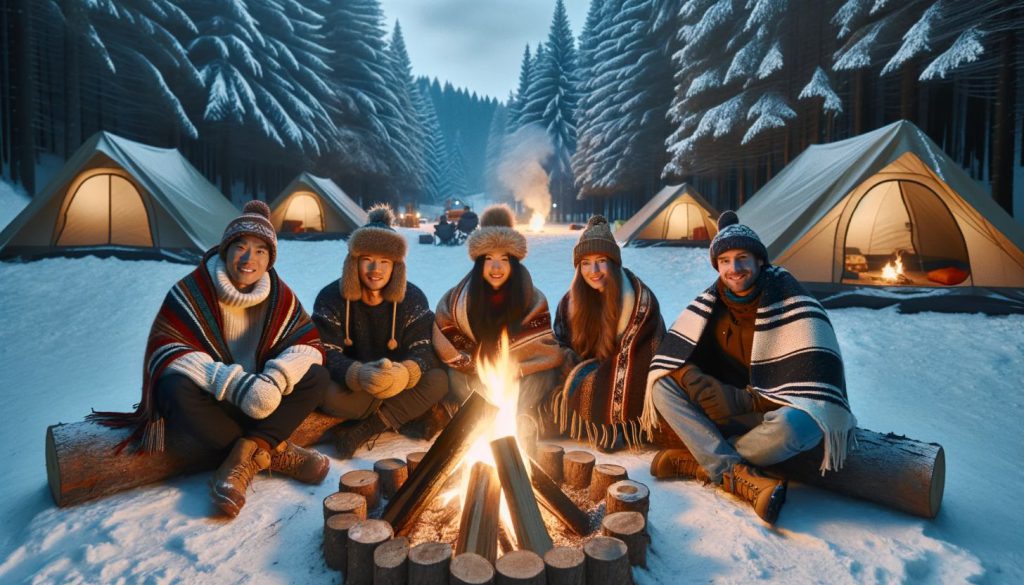
Using this checklist as a guide will help ensure you have all the necessary gear and clothing for a successful winter camping trip. Planning ahead and being prepared for the cold weather will allow you to fully enjoy the beauty and adventure of winter camping.
Choosing the Right Campsite
If you’re planning a winter camping trip, choosing the right campsite is crucial for a safe and enjoyable experience. Here are some things to consider:
- Proximity to water sources – Make sure there is access to nearby water sources, such as streams or lakes, for cooking and cleaning purposes. However, keep in mind that water sources may be frozen or difficult to reach in winter conditions.
- Shelter options – Look for campsites with natural shelter options, such as trees or rock formations, that can provide protection from the wind and snow. If natural shelter is not available, consider bringing a winter tent or snow shelter for added protection.
- Maximizing safety and comfort – When selecting a site, avoid areas with avalanche danger, such as steep slopes or terrain that slopes towards the campsite. Also, pay attention to the sun’s movement and choose a location that will receive plenty of sunlight during the day.
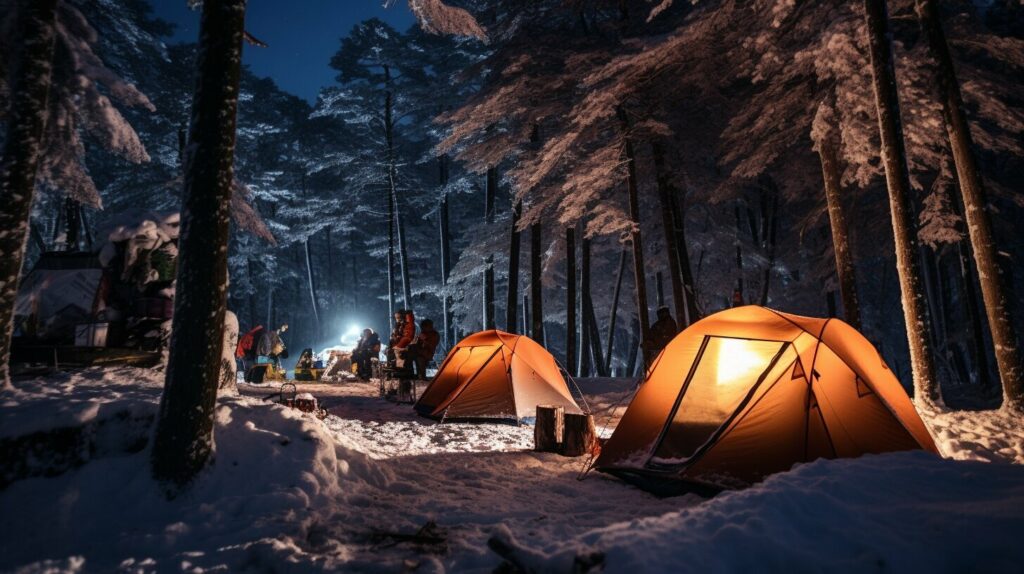
Winter camping requires additional considerations when pitching your tent and making camp. Take proper precautions for your safety and to ensure that you stay warm and comfortable during your trip. Here are some tips for setting up camp in winter:
Gear and Equipment
Make sure you have all the necessary gear and equipment to set up camp in winter weather conditions. This includes:
- Winter camping tent with a snow skirt or snow flaps to keep out cold wind and snow
- Groundsheet to insulate the ground and protect your tent from moisture
- Snow stakes or extra-long tent stakes to secure your tent in the snow
- Snow shovel to create a level surface for your tent and to dig out a vestibule for storing gear
- Hammer for driving in stakes and breaking up ice or frozen ground
It’s important to invest in high-quality gear that’s specifically designed for winter camping. This will ensure that you stay safe and comfortable throughout your trip.
Pitching Your Tent
When pitching your tent in winter conditions:
- Choose a level, sheltered spot that’s protected from the wind
- Clear away any snow to create a level surface for your tent
- Use snow stakes or extra-long tent stakes to secure your tent in the snow
- Use a groundsheet to insulate the ground and protect your tent from moisture
- Ensure your tent is pitched tightly to prevent drafts and heat loss
It’s also a good idea to use snow blocks to create an extra layer of insulation around your tent. Simply pile up snow around the perimeter of your tent to help keep out the cold winter air.
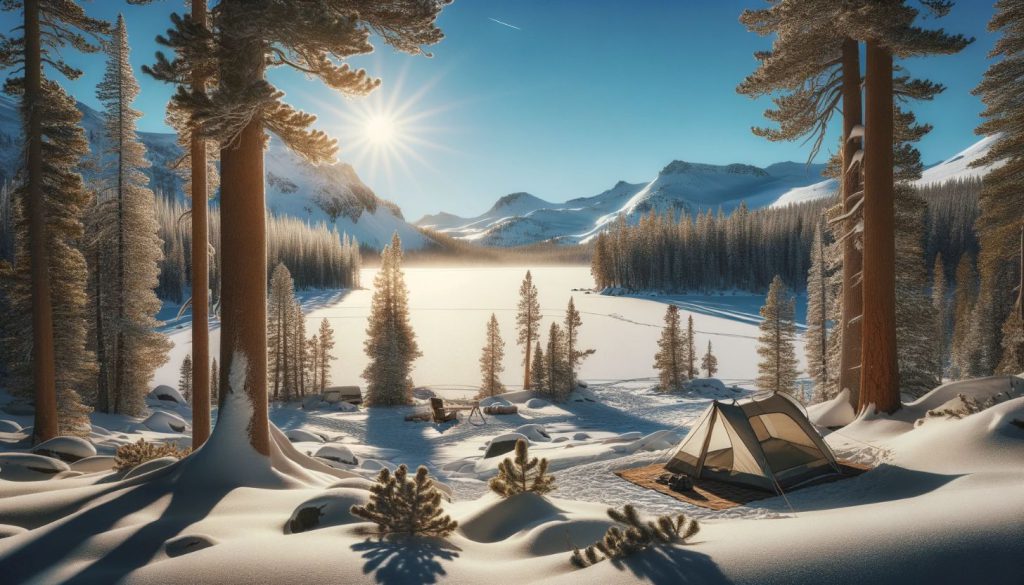
If you’re camping in an area with deep snow, you can take advantage of the snow by building snow structures to help insulate your tent and create extra shelter. Some ideas include:
- Snow walls: Build a wall of snow around your tent to protect it from wind and create an extra layer of insulation.
- Snow kitchen: Dig out a kitchen area from the snow, complete with a counter and seating area.
- Snow benches: Dig out benches from the snow for seating around the campfire.
- Snow shelter: Build a snow shelter, such as a quinzee or snow cave, for added protection from the elements.
Winter Camping Hacks
Here are some winter camping hacks to make your camping experience even more enjoyable:
- Use snow to your advantage – Build walls and snow shelters to block out wind and provide added insulation from the cold.
- Bring a shovel – Use a shovel to clear snow from the campsite, making room for your tent and other gear.
- Fill water bottles with hot water and place them in your sleeping bag at night to keep warm.
- Use chemical hand and feet warmers to warm up your extremities.
- Place your boots upside down in your sleeping bag at night to keep them warm and dry.
- Put a hot water bottle in your sleeping bag before bed to warm up your sleeping space.
- Keep your clothes, boots, and gear inside your tent to prevent them from freezing.
By following these tips for setting up camp in the winter, you can ensure a safe and comfortable camping experience.
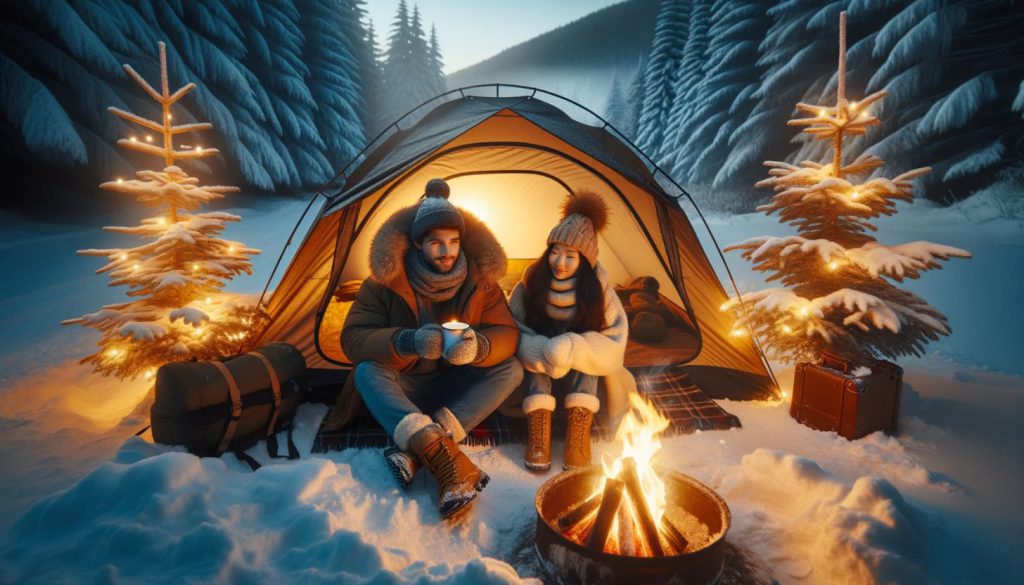
Staying Warm in Cold Weather
When camping in winter conditions, staying warm is essential for your safety and comfort. Below are some tips for insulating your body and keeping warm:
- Layer up: Wear multiple layers of clothing, including base layers, mid-layers, and outer layers, to trap warm air and insulate your body. Choose wool or synthetic fabrics that wick moisture away from your skin. Avoid cotton, as it holds moisture and can make you feel colder.
- Choose appropriate winter camping clothes: Bring warm winter boots, a waterproof jacket, and insulated pants to keep your body warm and dry. Don’t forget to wear a hat, gloves, and a scarf to protect your extremities from the cold.
- Use appropriate sleeping bags and pads: Choose a sleeping bag rated for the coldest temperatures you expect to encounter, and use a foam or inflatable sleeping pad to insulate yourself from the frozen ground. Place a reflective emergency blanket underneath your sleeping pad for added warmth.
- Use hand and feet warmers: Invest in disposable hand and feet warmers to keep your extremities warm. They can be a lifesaver on a cold winter night.
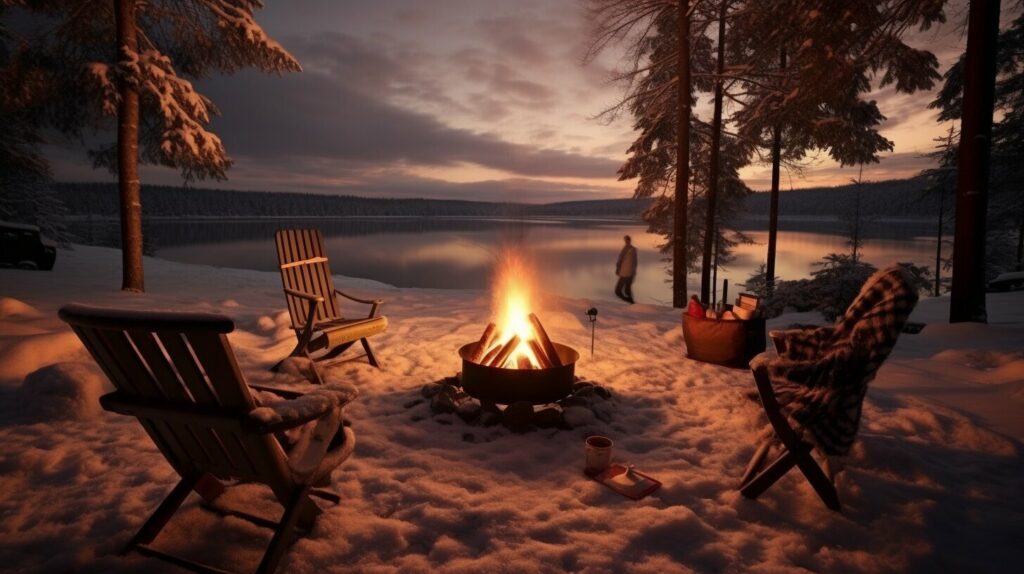
By following these winter camping essentials, you can stay warm and comfortable while exploring the great American outdoors.
Cooking and Food Tips for Winter Camping
When winter camping, it’s important to stay nourished and hydrated while ensuring your safety. Cooking outdoors in cold weather can be a challenge, but with the right know-how, it can also be enjoyable and satisfying. Follow these tips to make the most of your winter camping experience:
- Choose warm and nourishing meals: Opt for warm, high-energy meals that are easy to prepare and packed with essential nutrients. This can include soups, stews, and hot drinks like cocoa or tea. Pack foods that are easy to prepare and don’t require extensive cooking, such as instant oatmeal and canned goods.
- Invest in a reliable stove: Make sure you have a reliable stove that can withstand cold temperatures and provide consistent heat. Look for models that use propane or butane fuel, as they tend to perform better in cold weather than other types. Always follow the manufacturer’s instructions for use and safety.
- Prevent freezing and thawing issues: Keep your water bottles and food items from freezing by storing them in insulated containers and wrapping them in layers of clothing or blankets. Store your stove fuel and batteries in a warm place, such as inside a sleeping bag.
Remember to practice good hygiene and food safety while camping. Wash your hands before handling food, and keep perishable items chilled to prevent spoilage. Pack out all of your waste and dispose of it properly to minimize your impact on the environment.
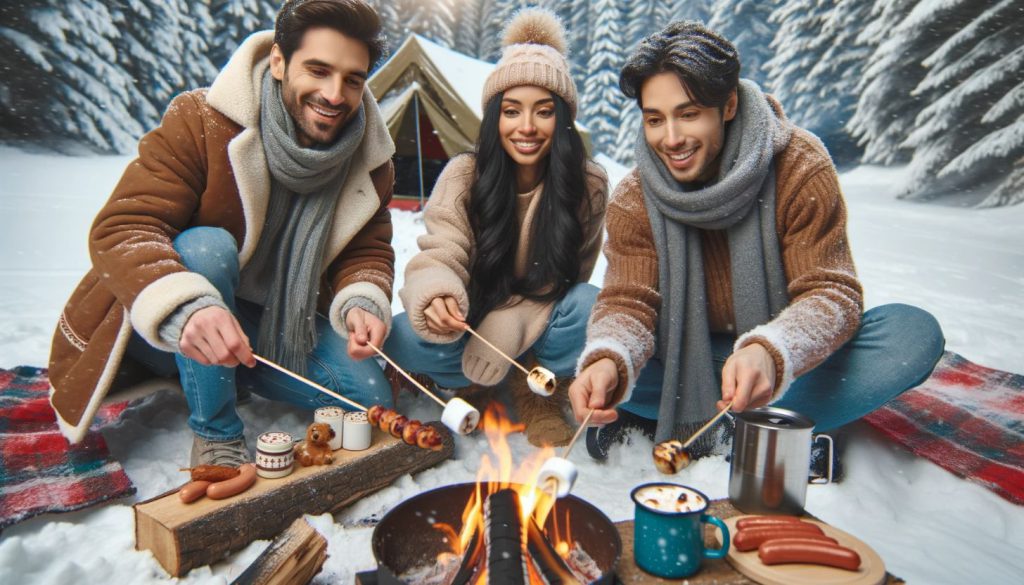
By following these cooking and food tips, you’ll stay nourished and energized during your winter camping trip. Don’t let the cold weather keep you from enjoying a hot and delicious meal!
Safety Precautions for Winter Camping
Winter camping comes with unique risks and hazards that require extra precautions to ensure your safety. Below are essential winter camping tips to keep you safe and secure:
| Tip | Description |
|---|---|
| Check the weather forecast | Winter weather conditions can be unpredictable, so be sure to check the forecast and plan accordingly. |
| Bring appropriate gear | Dress in layers, bring a warm sleeping bag and pad, and pack appropriate winter camping essentials. |
| Stay hydrated and well-fed | Drink plenty of water and stay well-fed to maintain energy and body heat. |
| Practice avalanche awareness | Before setting out, check for avalanche warnings and practice proper navigation techniques to avoid dangerous areas. |
| Carry a communication device | Bring a charged cell phone or a two-way radio for emergencies. |
| Know basic first aid | Carry a first aid kit and know how to treat hypothermia, frostbite, and other cold-weather injuries. |
| Plan for emergencies | Know emergency procedures and have a plan for getting help if needed. |
By following these safety precautions, you’ll be better prepared to handle any unexpected situations that may arise during your winter camping trip. Stay safe and enjoy your adventure!
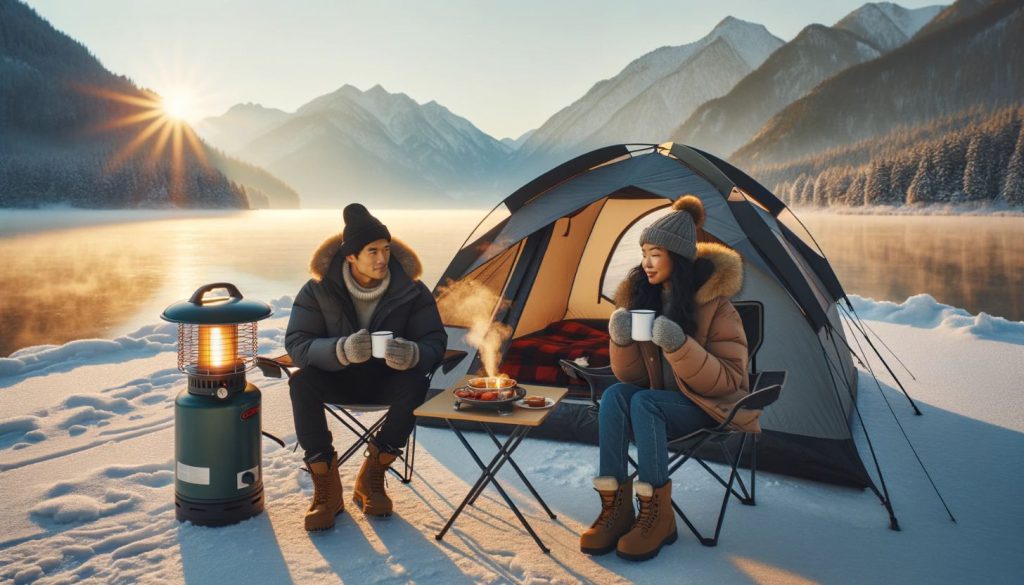
Gear Recommendations
Winter camping presents a unique opportunity to explore the great American outdoors in a whole new way. While the cold temperatures may seem daunting, with the right gear and knowledge, you can enjoy a range of exciting activities and make unforgettable memories. Here are some winter camping hacks and gear recommendations to help you make the most of your time in the winter wilderness:
- Go snowshoeing: A great way to explore trails and areas unreachable by skis or on foot.
- Cross-country skiing: An excellent cardiovascular workout that’s also low impact, cross-country skiing lets you explore miles of new terrain.
- Ice fishing: With the right equipment, you can make a hole in the ice and enjoy a unique fishing experience.
- Winter photography: The stark beauty of winter landscapes offers many creative opportunities for photography enthusiasts.
Of course, there are endless possibilities for winter camping activities, so choose what excites you most and get out there! Remember to dress appropriately for the activity and bring any necessary gear, such as snowshoes or skis. With the right preparation, you can have an incredible winter camping experience.
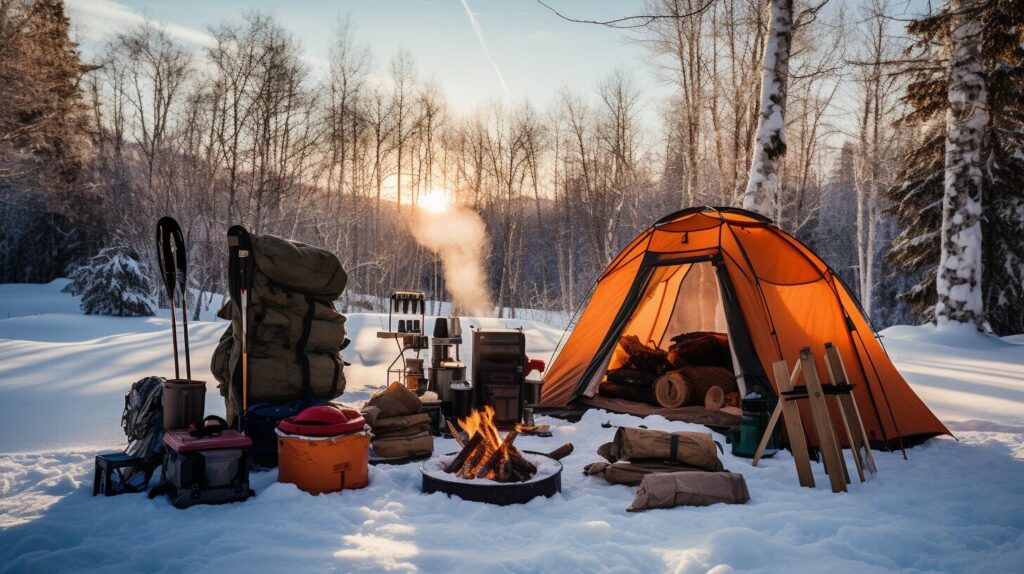
Winter camping gear can make or break your experience, so it’s important to choose wisely. Invest in high-quality gear designed specifically for cold weather camping, including:
| Item | Recommended Brand/Model |
|---|---|
| Sleeping bag | North Face Eco Trail Bed 20 |
| Sleeping pad | Therm-a-Rest NeoAir XTherm Max |
| Tent | Marmot Tungsten UL 3 |
| Clothing | Patagonia Nano Puff Jacket |
| Footwear | Columbia Bugaboot Plus IV Omni-Heat |
These recommendations are just a starting point; make sure to research gear options and choose what works best for you and your specific needs. With the right gear and a sense of adventure, you can embrace the winter wilderness like never before.
Conclusion
Winter camping may seem intimidating at first, but with proper planning and preparation, it can be a thrilling and rewarding adventure. By following our essential winter camping tips, you can stay warm, safe, and make unforgettable memories in the great American outdoors.
Remember to dress appropriately with multiple layers, have the right gear and equipment, and choose a suitable campsite. Insulate your body, cook warm and nourishing meals, and know and follow essential safety precautions. And above all, have fun and embrace the unique opportunities that winter camping offers!
FAQ
What are the essential items to bring for winter camping?
Essential items for winter camping include appropriate winter clothing, insulated sleeping bags, sleeping pads, a winter tent, warm and waterproof boots, hand and feet warmers, a stove for cooking, and extra layers of clothing for emergencies.
How do I choose the right campsite for winter camping?
When choosing a campsite for winter camping, consider factors such as proximity to water sources, availability of shelter options, and level ground for pitching a tent. Additionally, look for areas that provide wind protection and easy access to trails or recreational activities.
How do I stay warm in cold weather during winter camping?
To stay warm during winter camping, it’s important to layer your clothing, wear insulated and waterproof outerwear, use appropriate sleeping bags and pads, and utilize hand and feet warmers. Avoid sweating by adjusting your clothing layers according to your activity level.
What safety precautions should I take for winter camping?
Safety precautions for winter camping include avalanche awareness, proper navigation using maps and compasses, informing others about your trip plan, packing essential safety gear like a first aid kit and emergency communication devices, and being aware of weather conditions and potential hazards.
What are some winter camping activities and recreation options?
Winter camping offers various recreational opportunities such as snowshoeing, cross-country skiing, ice fishing, winter photography, and building snow structures. Engaging in these activities can enhance your winter camping experience and allow you to enjoy the winter wonderland.

